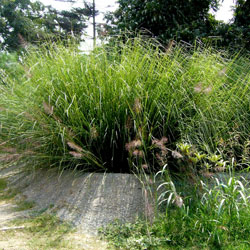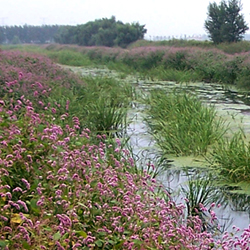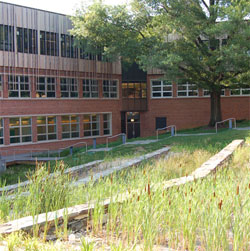Professional Practice
Green Infrastructure: Constructed Wetlands
Wetlands retain and filter water and support water-loving vegetation and soils. Some remain saturated with water year-round, while others go through wet and dry cycles. They fulfill critical ecological needs, cycling nutrients and providing habitat for a range of species. They frequently serve as buffers or transitional environments between different ecosystems.
Constructed wetlands mimic the functions of natural wetlands to capture stormwater, reduce nutrient loads, and create diverse wildlife habitat. They are often created in engineered growth media in trenches, small islands, and pools. They are designed to contain water at all times -- either standing water on the surface or water saturated just below the soil surface.
Constructed wetlands may be build expressly for capturing and filtering stormwater or wastewater treatment. Plant can be chosen for performance, so constructed wetlands often do not contain the breadth of vegetation found in natural or restored wetlands, or provide all of their ecological services.
Benefits of constructed wetlands include:
- The Staten Island Bluebelt Drainage Basins in New York City use
strategically placed wetlands within a watershed to temporarily store and
filter 350,000 gallons of stormwater during storm events. It drains over 14,000
acres and saves over $80 million in conventional sewer costs. (1)
- According to the Environmental Protection Agency (EPA), constructed wetlands effectively
removed approximately 45 percent of total nitrogen and approximately 60 percent of total
suspended solids. Size was not a significant variable in determining wetlands performance. (2)
- In 1995, the Seadrift water treatment facility in Texas was seeking a solution to consistently meet regulatory requirements for water discharge. An innovative green infrastructure solution consisting of a 110-acre constructed wetland, in lieu of an industrial wastewater treatment plant, was installed. It has successfully operated for the past 15 years. A considerably larger footprint was needed for the wetlands -- 110 acres as opposed to 4-5 acres for a gray infrastructure alternative -- and the project required a 1-2 year pilot period to de-risk the technology and find the optimum design. However the wetlands have been found to offer the following advantages:
- Capital expense savings: $1.2-1.4 million versus $40 million for the gray infrastructure alternative proposed;
- Operating expense savings: no energy, additives, or oxygen; no biosolids disposal; minimal maintenance;
- Lower environmental footprint: eliminated the need for the construction and operation of an energy-intensive wastewater treatment facility;
- Labor reduction: Operational support drastically different; a wetland requires minimal support from operations and maintenance as opposed to the gray alternative requiring 24/7 support;
- Operational performance: 100 percent compliant upon start-up and for over 15 years;
- Construction benefits: project implementation time reduced by half (fully operational in 18 months);
- Other benefits: provides habitat for deer, bobcats, and birds; educational opportunities for local schools (2)
Sources:
1. Columbia University Water Center
2. The Nature Conservancy with Dow, Swiss Re, Shell, and Unilever Companies
Organizations
Resources
, Center for Environmental Excellence by the American Association of State Highway and Transportation Officials
Take Part, 6/26/2014
Grist, 10/28/2013
Inhabitat, 8/26/2013
The Atlantic / CityLab, 1/8/2013
"," The Dirt, 7/23/2011
"," The Dirt, 06/18/2009
Government Resources
State of Delaware Department of Natural Resources and Environmental Control
, U.S. Environmental Protection Agency
, US Fish and Wildlife Service
Research
 Constructed Wetland in Peru / Image credit: Sustainable Sanitation Alliance
Constructed Wetland in Peru / Image credit: Sustainable Sanitation Alliance
"," U.S. Department of the Interior, Fish and Wildlife Service and National Oceanic and Atmospheric Administration, National Marine Fisheries Service, 2013
U.S. Environmental Protection Agency Office of Research and
Development 2012
International Erosion Control Association - Northeast Conference, 2012
SUNY-ESF with Environmental Finance Center at the Syracuse Center of Excellence, 2011
Journal of Environmental Engineering, 2011
Journal
of Environmental Engineering, 2009
The Society of Wetland Scientists, 2009
The Nature Conservancy with Dow, Swiss Re, Shell, and Unilever Companies, 2013
Role of the Landscape Architect
 ËżąĎĘÓƵ 2012 Professional Analysis and Planning Honor Award, Core Area of Lotus Lake National Wetland Park Landscape Planning, Tieling City, Liaoning Province, China, Beijing Tsinghua Urban Planning & Design Institute / Image Credit: Beijing Tsinghua Urban Planning & Design Institute
ËżąĎĘÓƵ 2012 Professional Analysis and Planning Honor Award, Core Area of Lotus Lake National Wetland Park Landscape Planning, Tieling City, Liaoning Province, China, Beijing Tsinghua Urban Planning & Design Institute / Image Credit: Beijing Tsinghua Urban Planning & Design Institute
Landscape architects integrate constructed wetlands into urban, suburban, and rural communities. In master planning, they must consider sources and flow of water within a hydrological system, the sources of pollution and wastewater, and then appropriately site the constructed wetlands to absorb the water and deal with the pollution.
Landscape architects work with ecologists and environmental engineers to specify appropriate vegetation and growth media for constructed wetland systems. Especially in more densely populated areas, landscape architects ensure that plant choices, design form, and construction materials are chosen for both ecological functionality and social aesthetics.
Projects
A Green Sponge for a Water-Resilient City: Qunli Stormwater Park, Haerbin City, Heilongjiang Province, China (Turenscape and Peking University)
, Cambridge, MA (SEA Consultants)
Playa Vista, CA.
 Sidwell Friends constructed wetland, Washington, D.C. Andropogon Associates / Image credit: Sidwell Friends School
Sidwell Friends constructed wetland, Washington, D.C. Andropogon Associates / Image credit: Sidwell Friends School
Core Area of Lotus Lake National Wetland Park Landscape Planning, Tieling City, Liaoning Province, China (Beijing Tsinghua Urban Planning & Design Institute)
, Willamette Valley, OR (Biohabitats)
Tin Shui Wai, New Territories, Hong Kong, China (Urbis Limited)
Sidwell Friends, Washington, DC (Andropogon Associates)
Shanghai Houtan Park: Landscape as a Living System, Shanghai, China (Turenscape and Peking University Graduate School of Landscape Architecture)
Teardrop Park, New York, NY (Michael Van Valkenburgh Associates, Inc.)
<< Urban
Green Roofs & Walls >>